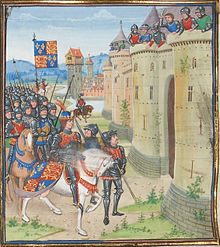| Siege of Berwick | |||||||||
|---|---|---|---|---|---|---|---|---|---|
| Part of the Second War of Scottish Independence | |||||||||
 A medieval depiction of Edward III at the siege of Berwick | |||||||||
| |||||||||
| Belligerents | |||||||||
|
|
| ||||||||
| Commanders and leaders | |||||||||
|
|
| ||||||||
| Strength | |||||||||
| Up to 20,000 | Less than 10,000 | ||||||||
| Casualties and losses | |||||||||
| Unknown. Surviving garrison capitulated and were allowed to leave | Very few | ||||||||
Location of the siege within Scotland | |||||||||
The siege of Berwick lasted four months in 1333 and resulted in the Scottish-held town of Berwick-upon-Tweed being captured by an English army commanded by King Edward III (r. 1327–1377). The year before, Edward Balliol had seized the Scottish Crown, surreptitiously supported by Edward III. He was shortly thereafter expelled from the kingdom by a popular uprising. Edward III used this as a casus belli and invaded Scotland. The immediate target was the strategically important border town of Berwick.
An advance force laid siege to the town in March. Edward III and the main English army joined it in May and pressed the attack. A large Scottish army advanced to relieve the town. After unsuccessfully manoeuvring for position and knowing that Berwick was on the verge of surrender, the Scots felt compelled to attack the English at Halidon Hill on 19 July. The Scots suffered a crushing defeat, and Berwick surrendered on terms the next day. Balliol was reinstalled as king of Scotland after ceding a large part of his territory to Edward III and agreeing to do homage for the balance.
